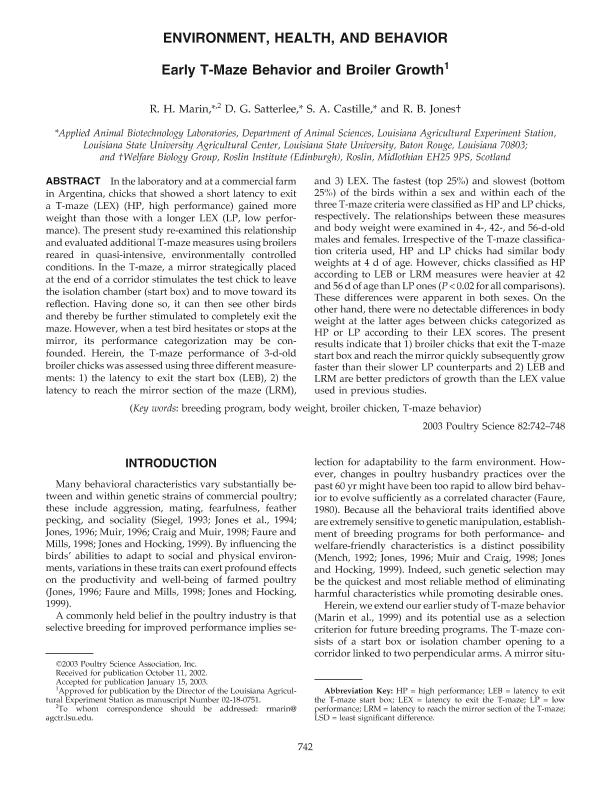Mostrar el registro sencillo del ítem
dc.contributor.author
Marin, Raul Hector

dc.contributor.author
Satterlee, D. G.
dc.contributor.author
Castille, S.A.
dc.contributor.author
Jones, R. B.
dc.date.available
2018-12-20T14:43:13Z
dc.date.issued
2003-05-01
dc.identifier.citation
Marin, Raul Hector; Satterlee, D. G.; Castille, S.A.; Jones, R. B.; Early T-maze behavior and broiler growth; Poultry Science Association; Poultry Science; 82; 5; 1-5-2003; 742-748
dc.identifier.issn
0032-5791
dc.identifier.uri
http://hdl.handle.net/11336/66820
dc.description.abstract
In the laboratory and at a commercial farm in Argentina, chicks that showed a short latency to exit a T-maze (LEX) (HP, high performance) gained more weight than those with a longer LEX (LP, low performance). The present study re-examined this relationship and evaluated additional T-maze measures using broilers reared in quasi-intensive, environmentally controlled conditions. In the T-maze, a mirror strategically placed at the end of a corridor stimulates the test chick to leave the isolation chamber (start box) and to move toward its reflection. Having done so, it can then see other birds and thereby be further stimulated to completely exit the maze. However, when a test bird hesitates or stops at the mirror, its performance categorization may be confounded. Herein, the T-maze performance of 3-d-old broiler chicks was assessed using three different measurements: 1) the latency to exit the start box (LEB), 2) the latency to reach the mirror section of the maze (LRM), and 3) LEX. The fastest (top 25%) and slowest (bottom 25%) of the birds within a sex and within each of the three T-maze criteria were classified as HP and LP chicks, respectively. The relationships between these measures and body weight were examined in 4-, 42-, and 56-d-old males and females. Irrespective of the T-maze classification criteria used, HP and LP chicks had similar body weights at 4 d of age. However, chicks classified as HP according to LEB or LRM measures were heavier at 42 and 56 d of age than LP ones (P < 0.02 for all comparisons). These differences were apparent in both sexes. On the other hand, there were no detectable differences in body weight at the latter ages between chicks categorized as HP or LP according to their LEX scores. The present results indicate that 1) broiler chicks that exit the T-maze start box and reach the mirror quickly subsequently grow faster than their slower LP counterparts and 2) LEB and LRM are better predictors of growth than the LEX value used in previous studies.
dc.format
application/pdf
dc.language.iso
eng
dc.publisher
Poultry Science Association

dc.rights
info:eu-repo/semantics/openAccess
dc.rights.uri
https://creativecommons.org/licenses/by-nc-sa/2.5/ar/
dc.subject
Body Weight
dc.subject
Breeding Program
dc.subject
Broiler Chicken
dc.subject
T-Maze Behavior
dc.subject.classification
Otras Ciencias Biológicas

dc.subject.classification
Ciencias Biológicas

dc.subject.classification
CIENCIAS NATURALES Y EXACTAS

dc.title
Early T-maze behavior and broiler growth
dc.type
info:eu-repo/semantics/article
dc.type
info:ar-repo/semantics/artículo
dc.type
info:eu-repo/semantics/publishedVersion
dc.date.updated
2018-11-12T13:44:59Z
dc.identifier.eissn
1525-3171
dc.journal.volume
82
dc.journal.number
5
dc.journal.pagination
742-748
dc.journal.pais
Reino Unido

dc.journal.ciudad
Champaign Il
dc.description.fil
Fil: Marin, Raul Hector. Consejo Nacional de Investigaciones Científicas y Técnicas; Argentina. State University of Louisiana; Estados Unidos
dc.description.fil
Fil: Satterlee, D. G.. State University of Louisiana; Estados Unidos
dc.description.fil
Fil: Castille, S.A.. State University of Louisiana; Estados Unidos
dc.description.fil
Fil: Jones, R. B.. Roslin Institute; Reino Unido
dc.journal.title
Poultry Science

dc.relation.alternativeid
info:eu-repo/semantics/altIdentifier/url/https://academic.oup.com/ps/article/82/5/742/1579432
dc.relation.alternativeid
info:eu-repo/semantics/altIdentifier/doi/https://dx.doi.org/10.1093/ps/82.5.742
Archivos asociados
